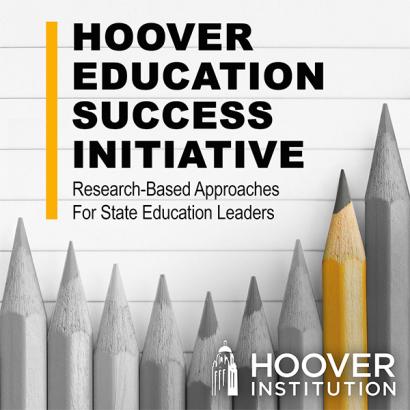- Education
- K-12
- Reforming K-12 Education
Senior fellow Eric Hanushek and Hoover’s Education Success Initiative have published new research showing that declines in elementary math and reading scores began in most of the United States years before the start of the COVID-19 pandemic. He spoke with Chris Herhalt about his research and ways to remedy the decline.
Chris Herhalt: In your state-specific data, the trend is clear. After about 2013 or 2014, both math and reading scores—for younger elementary grades and older grades—drop off a cliff. What do you think contributed to the decline?
Eric Hanushek: We don’t have a good understanding of what is driving these. That leads to all kinds of speculation that it’s all cell phones, or it’s all changes in attitudes about schooling. Also, layered on top of it is a major change in the way we have accountability for school performance that occurs in 2015. It’s really hard to distinguish what’s behind it, but it is a huge change that has large long-term implications.
Chris Herhalt: Is there any validity to the growing suspicion that phones and tablets are to blame?
Eric Hanushek: I think there’s probably something like that going on, but you don’t see that uniformly around the world. Everybody has phones around the world, including in the least developed parts. I think cell phones have complicated the world, but I don’t think that it’s a good explanation for everything that’s going on.
Chris Herhalt: What about the change to accountability measures, starting in 2015? The report A Nation at Risk +40, which you participated in as co-leader of the Hoover Education Success Initiative, talked a lot about that.
Eric Hanushek: The federal government started insisting that all states had accountability under No Child Left Behind [Act] of 2001, which set unrealistic targets that said there should be no student who isn’t proficient in reading and math by 2013. It became evident that every school in the country would be a failure, and this led to huge backlash against federal accountability and No Child Left Behind. In 2015, we had a change in federal law that relieved all the pressure and basically turned accountability back to the states. My own assessment is that a number of the states, in fact, slacked off on accountability because there was no longer any federal pressure.
Chris Herhalt: In your new research, individual state assessments are based on National Assessment of Educational Progress [NAEP] scores. You find that “for both math and reading in grades four and eight, the variance of the NAEP scores in 2024 is larger than in any prior year of testing.” Those are the high achievers and the low achievers. What do you think ought to be done to keep that gap between high and low achievers from widening?
Eric Hanushek: I think providing good education for everybody is the answer. What we see is that the lowest achievers took a larger portion of the fall [in test scores] after 2013. It may be that the parents of high achievers are an important part of their high achieving and they kept the pressure on their kids, whereas the pressure wasn’t so much on the lower achievers. At the same time we also had an increase in absenteeism that I didn’t mention before, but that has to be part of it. You don’t learn the same things when you’re not in school and not doing schoolwork.
We have a number of large city school systems where more than half the kids are absent more than twenty days out of the year. This is incredible to somebody like me who went to school where people were given awards for perfect attendance.
Chris Herhalt: I’ll try to grab a bit of a silver lining in your findings. You do find the declines in math and reading in the post-pandemic era, from 2022 to 2024, sort of flattening, bottoming out. Can we take anything good from that?
Eric Hanushek: Well, I think that’s part of the overall story. We spent a lot of additional federal money to try to deal with the pandemic: $190 billion worth of federal funds that went largely to the schools. That didn’t even bring us back to where we were at the end of the pandemic, which I find to be pretty startling. We’ve had this decline in test scores since 2013 and the pandemic is sort of layered on top of it. The pandemic obviously accelerated the declines, but it appears to me from the fact that we continue having declines after 2022 that there’s a more fundamental change going on underneath the pandemic. It appears that, had we not had a pandemic, we still would have seen declines.
Chris Herhalt: That’s a message you’ve communicated several times, but I don’t think it’s hit home yet.
Eric Hanushek: I’m trying.
Chris Herhalt: I know you are. But the general public seems to think, well, we had the pandemic and schools closed, so there you go.
Eric Hanushek: The pandemic was such a shock to the system that it absorbed all of our energy and all of our attention. The responses to school achievement during and after the pandemic were to try to add more time to the school day, or some focused tutoring—efforts that were just trying to make up for the symptoms of the pandemic. Kids weren’t in school as much and were a bit disrupted. The changes did nothing to alter this decline.
Chris Herhalt: In your earlier work, you discussed making the school year longer, adding summer school, looking for helpful technology, doing direct tutoring. But you say in your new report that either those things have not been broadly employed or they haven’t been implemented properly. What else can we do?
Eric Hanushek: Well, in my opinion, we have to more fundamentally rethink how we’re providing education. This dovetails with the Education Futures Council work, which laid out some ideas about changing some of the underlying fundamental institutional structure.
One of the things that lead me to this conclusion is that we do have examples of systems that are working. We have Washington, DC, which since 2010 has been improving over time, and I think most of the improvement can be attributed to changing the way we evaluate school and teacher performance and the way we reward teachers. They radically changed the evaluation of teachers, and the best teachers got large increases in their base pay to try to keep them there. The worst teachers got fired. Washington actually fired five hundred or six hundred teachers because of this evaluation system, and also induced a lot more poor teachers to leave the system.
In Dallas, they went even further. They changed the entire pay system for teachers and principals. They now make evaluations almost entirely based upon effectiveness at their job of teaching kids, and reward them for that, and have policies designed to employ them according to their performance. These are public examples that you would think would be copied elsewhere. But most other places haven’t copied these concepts.
We have more than thirteen thousand school districts. The vast majority of them have ignored the fact that we have examples at scale: large-city school systems that continue to operate differently and get performance. Yet they don’t adopt these reforms. If they really were focused on student achievement, we would see some of these examples being copied more broadly.
So, the reason for that long explanation is that I think the fundamental thing is to organize our schools to focus much more sharply on student outcomes and student achievement, and not pay as much attention to issues of adult employment as we do today.
This interview was edited for length and clarity.

















